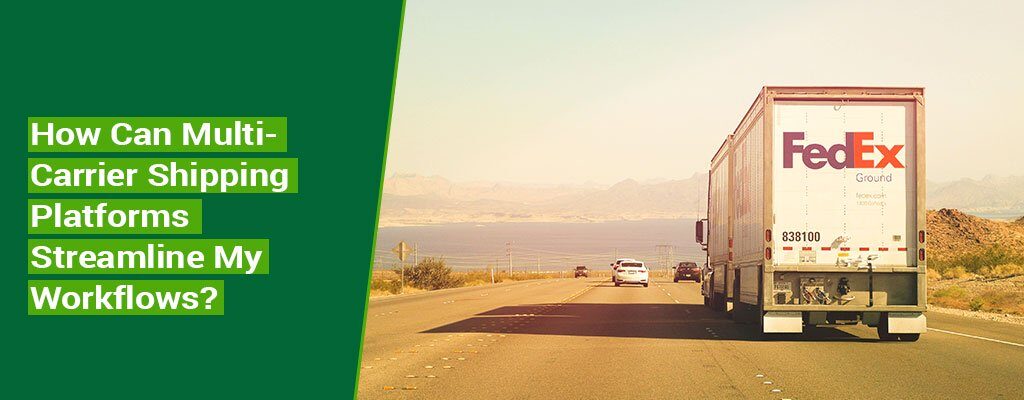How Can Multi-Carrier Shipping Platforms Streamline My Workflows?
Contents
The greater the distance a parcel or document has to travel, the more likely shipping inefficiencies are to occur. This may seem counterintuitive at first, but it is true. You might think that according to purely geographical terms, having a single carrier take a parcel from its expeditor to its destination is the most efficient way to ship. But we don’t live in a purely geographical world.
International shipments and cross-country domestic shipments often suffer from lack of infrastructure. A shipping provider based in the origin city may not have enough of a presence in the destination city to make a cost-efficient delivery there in a short period of time.
But customers still demand their parcels arrive as quickly as possible. As technology advances and consumers become accustomed to enjoying immediate resolutions for their problems, impatience will only grow.
Multi-carrier shipping platforms offer the ability to solve these infrastructural issues. By optimizing carrier routes to use the fastest, lowest-cost option automatically, businesses can effectively extend their shipping networks worldwide, at little to no extra cost.
What is a Multi-Carrier Shipping Platform?
One of the most famous examples of a global multi-carrier shipping platform is eBay and Pitney Bowes’ Global Shipping Program. Starting in 2012, eBay and Pitney Bowes began working on a joint solution that would allow eBay sellers to sell their goods internationally while enjoying competitive shipping rates.
Until then, the viability of being a worldwide seller was steeply limited by international shipping costs. Unsubsidized single-carrier international shipping rates can easily double the prices of many everyday consumer goods.
For an American eBay store owner, this meant that international markets like Germany and Japan were effectively infeasible for all but the most expensive or in-demand items. On its own, the USPS could not ensure the lowest possible price and best possible delivery time for an international shipment of this kind because it doesn’t have enough international infrastructure.
But the Global Shipping Program solves this problem by putting the USPS on equal footing with its foreign analogues and private shipping carriers alike. Pitney Bowes’ system compares rates automatically and then allocates packages to the most efficient route.
For a package sent from the United States to Germany, this could mean using the USPS shipping platform for local pickup, transferring to the FedEx shipping platform for overseas travel, and then using the UPS shipping platform to deliver the parcel to its destination. When all three systems cooperate, they achieve better speed and efficiency than when siloed against one another.
This is just one example of how cooperative economics works in an open-ended system. While many economists define capitalist enterprise in terms of competition, cooperation is actually a greater value generator in today’s hyper-connected technological landscape.
How Do Multi-Carrier Shipping Platforms Work?
Unsurprisingly, multi-carrier shipping platforms are complex. As ecommerce mailing solutions, they offer enormous value to consumers and manufacturers alike, but they require intelligent automation to run.
Pitney Bowes mailing solutions use intelligent automation to find the most efficient routes for its customers. These automated processes focus on three key items of information.
- Location. In order to develop sustainable ecommerce mailing services, multi-carrier shipping platforms need to map out warehouse, store, and dropship locations and then compare them to high-volume destinations. Analytics of previous shipping data is an important tool for determining optimal location.
- Carrier Type. Global carriers like FedEx and UPS tend to charge more for long-haul deliveries than regional carriers do. Connecting regional carriers to global ones and identifying opportunities for cross-carrier efficiency makes the multi-carrier shipping platform work.
- Flexibility. Multi-carrier shipping is all about flexibility. Without flexible workflows and software-driven processes, there are bound to be difficulties in “translating” orders from one carrier to another. Optimizing flexibility allows carriers to handle any parcel under all but the most unorthodox conditions.
Carriers are beginning to see the value of this multifaceted, cooperative approach. This is why major global carriers like FedEx are acquiring regional carriers, often paying enormous sums for the privilege.
Implement Multi-Carrier Shipping for Your Business
This logistics framework is more than an ecommerce mailing solution. Any company that regularly sends out high-volume parcels can benefit from Pitney Bowes mailing services the way eBay has. Multi-carrier shipping frameworks can help with domestic deliveries and international deliveries alike.
Any company looking for opportunities to grow its customer base through increased geographical presence and Internet-powered marketing can potentially use multi-carrier solutions to deliver. The key is working with a reliable partner that can ensure your shipping processes become efficient, automated tasks designed for optimal efficiency.
Are you ready to reduce shipping costs and delivery times using an automated multi-carrier shipping platform? Contact Kelley Create to get an assessment!



